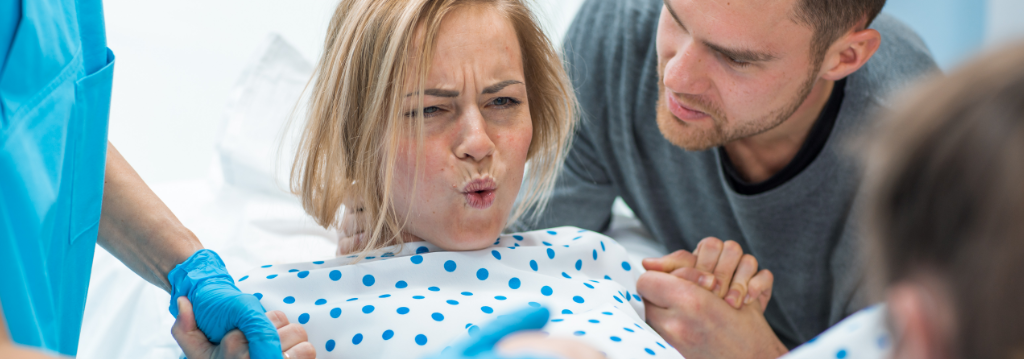
1942, an age where birth had been overtaken by obstetrics and medicalization, Dr. Grant Dick- Read’s book, Natural Childbirth introduced birth in a gentle manner. Exploring the baby’s own experience and the theory that fear and tension induced more pain. At this time these concepts were seen as radical.
The Bradley method was developed in 1947 by Dr. Robert Bradley, an Obstetrician who believed in partner participation and controlled breathing methods. He felt these methods helped bring focus inwards rather than be distracted from the process. Before Dr. Bradley, partners were not invited into the birthing room. They were expected to stay in the waiting area or come in once the baby had been born. (2)
The concept of using specific breathing techniques to help birthing individuals produce a conscious state of relaxation for labour was created by French Obstetrician, Fernand Lamaze in the 1950’s. These methods were taught to Marjorie Karmel in her experience at Lamazes’ clinic in Paris and along with Elisabeth Bing and The American Society for Psychoprophylaxis (ASPO), which would go on to be known as Lamaze International, began promoting these techniques to others.
Word spread quickly as many childbirth educators became trained in the methods of Lamaze breathing. It was revolutionizing at the time for individuals seeking ways to cope and manage their labour experience without the need for medication.
The breathing patterns being taught were thought to be effective as a source of distraction and relaxation. Reducing pain perception and shifting focus to help people birth without medications despite being confined to bed during labour. There were several breathing patterns and strict guidelines for “correct breathing techniques” allowing to be “awake and aware.”
In present day, Lamaze breathing is quite different from the breathing techniques first introduced. Strict breathing techniques were dropped from the teachings in the 1980s and now conscious breathing and relaxation in addition to movement are suggested to manage pain and facilitate labor.
By 1987 the Hypnobirthing movement had come into being. Michelle Leclaire O’Neill, authored books on the subject including Hypnobirthing: The Original Method. Her work was based partly on previous research by Dr. Grant Dick-Read. Another follower, Marie Mongan practiced Dick-Reed’s techniques during her own labour and became a convert to this method. Marie then founded the Hypnobirthing Institute, and the method continued to spread throughout North America.
In 1989, HypnoBabies was founded by Kelly Tuschhoff to assist women through childbirth using hypnosis techniques and audio tracks. It is thought that reaching a state of hypnosis through breathing, deep relaxation and trusting the body’s natural ability could result in giving birth with ease and comfort.
In 1993, The Alexander Technique Birth was published. Alexander had many instructions for birth; encouraging freedom of movement, balance, flexibility and a practiced breathing technique called “whispered ah,” where the birthing individual was encouraged to think of something funny or to smile to release jaw tension. It is believed there is a connection between the tension in the jaw and the cervix and so by encouraging low breath sounds in birthing individuals it helps to relax the mouth and throat muscles.
As time goes on, awareness of the connection between the body and the mind is becoming more prevalent, with publications such as Ina May Gaskins’ Guide to Childbirth (2003).
In the 2012 release of Mindful Birthing, Nancy Bardacke used focused breathing to quiet the wandering mind. Bardacke adds that during the stress that occurs in childbirth, “we inadvertently trigger the fight or flight response and reduce the flow of oxytocin when needed the most.” (4)
In 2019, ACOG stated, “when not coached to breathe in a specific way, [people] push with an open glottis. In consideration of the limited data regarding superiority of spontaneous versus valsalva pushing, each [person] should be encouraged to use [their] preferred and most effective technique.”
As time goes on we continue to learn and evolve new methods of relaxation during childbirth. Moving from orchestrated breathing patterns to following one’s own instincts. Although techniques vary, many encourage slow, deep, controlled breathing in a conscious manner.
Sources
- “What Every Pregnant Woman Needs to Know”. Lamaze Breathing. Judith A. Lothian, PhD, RN, LCCE, FACCE. J Perinat Educ. 2011 Spring; 20(2): 118–120. doi: 10.1891/1058-1243.20.2.118 PMCID: PMC3209750
- “What is the Bradley Method”. June 25, 2019. Rachel Gurevich, RN. Medically reviewed by Anita Sadaty, MD. Retrieved from https://www.verywellfamily.com/the-bradley-method-4586903
- “History of Hypnobirthing”. Retrieved from https://www.kghypnobirthing.com/pregnancy-information/history-of-hypnobirthing/how-childbirth-hypnotherapy-began.html
- “Unlaboured Breathing”. Lamaze International. June Connell. Dec. 15, 2013. Retrieved from https://www.lamaze.org/Giving-Birth-with-Confidence/GBWC-Post/unlabored-breathing“
About the Author
Sonya Duffee’s journey towards supporting and empowering families through birth began shortly after the birth of her own children. With more than 16 years experience in a variety of birth settings including home births, hospital and birth center providing prenatal, birth and postnatal care to expectant families in the community.

I took my first childbirth Lamaze class in 1981 and used this breathing method through each of my 8 births and had no epidurals.